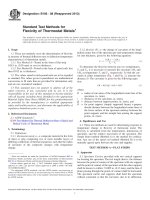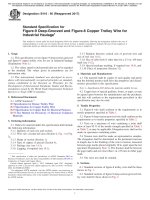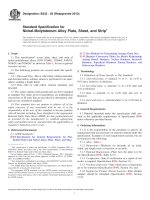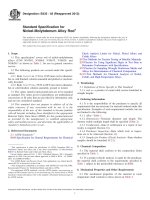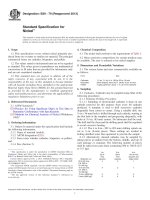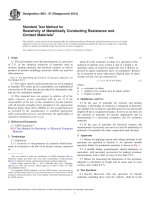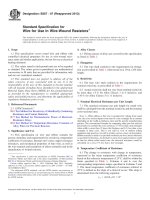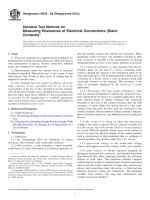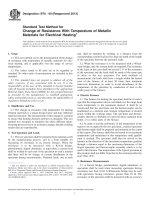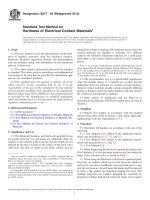Astm b 650 95 (2013)
Bạn đang xem bản rút gọn của tài liệu. Xem và tải ngay bản đầy đủ của tài liệu tại đây (106.23 KB, 5 trang )
Designation: B650 − 95 (Reapproved 2013)
Standard Specification for
Electrodeposited Engineering Chromium Coatings on
Ferrous Substrates1
This standard is issued under the fixed designation B650; the number immediately following the designation indicates the year of
original adoption or, in the case of revision, the year of last revision. A number in parentheses indicates the year of last reapproval. A
superscript epsilon (´) indicates an editorial change since the last revision or reapproval.
This standard has been approved for use by agencies of the U.S. Department of Defense.
B320 Practice for Preparation of Iron Castings for Electroplating
B374 Terminology Relating to Electroplating
B487 Test Method for Measurement of Metal and Oxide
Coating Thickness by Microscopical Examination of
Cross Section
B499 Test Method for Measurement of Coating Thicknesses
by the Magnetic Method: Nonmagnetic Coatings on
Magnetic Basis Metals
B504 Test Method for Measurement of Thickness of Metallic Coatings by the Coulometric Method
B507 Practice for Design of Articles to Be Electroplated on
Racks
B568 Test Method for Measurement of Coating Thickness
by X-Ray Spectrometry
B571 Practice for Qualitative Adhesion Testing of Metallic
Coatings
B602 Test Method for Attribute Sampling of Metallic and
Inorganic Coatings
B697 Guide for Selection of Sampling Plans for Inspection
of Electrodeposited Metallic and Inorganic Coatings
B762 Test Method of Variables Sampling of Metallic and
Inorganic Coatings
B849 Specification for Pre-Treatments of Iron or Steel for
Reducing Risk of Hydrogen Embrittlement
B850 Guide for Post-Coating Treatments of Steel for Reducing the Risk of Hydrogen Embrittlement
D3951 Practice for Commercial Packaging
E8 Test Methods for Tension Testing of Metallic Materials
F1459 Test Method for Determination of the Susceptibility
of Metallic Materials to Hydrogen Gas Embrittlement
(HGE)
2.2 Other Standard:
MIL-S-13165 Shot Peening of Metal Parts3
1. Scope
1.1 This specification covers the requirements for electrodeposited chromium coatings applied to ferrous alloys for engineering applications.
1.2 Electrodeposited engineering chromium, which is sometimes called “functional” or “hard” chromium, is usually
applied directly to the basis metal and is much thicker than
decorative chromium. Engineering chromium is used for the
following:
1.2.1 To increase wear and abrasion resistance,
1.2.2 To increase fretting resistance,
1.2.3 To reduce static and kinetic friction,
1.2.4 To reduce galling or seizing, or both, for various metal
combinations,
1.2.5 To increase corrosion resistance, and
1.2.6 To build up undersize or worn parts.
1.3 This standard does not purport to address all of the
safety concerns, if any, associated with its use. It is the
responsibility of the user of this standard to establish appropriate safety and health practices and determine the applicability of regulatory limitations prior to use.
2. Referenced Documents
2.1 ASTM Standards:2
B117 Practice for Operating Salt Spray (Fog) Apparatus
B177 Guide for Engineering Chromium Electroplating
B183 Practice for Preparation of Low-Carbon Steel for
Electroplating
B242 Guide for Preparation of High-Carbon Steel for Electroplating
1
This specification is under the jurisdiction of ASTM Committee B08 on
Metallic and Inorganic Coatings and is the direct responsibility of Subcommittee
B08.03 on Engineering Coatings.
Current edition approved Dec. 1, 2013. Published December 2013. Originally
approved in 1978. Last previous edition approved in 2008 as B650 – 95(2008). DOI:
10.1520/B0650-95R13.
2
For referenced ASTM standards, visit the ASTM website, www.astm.org, or
contact ASTM Customer Service at For Annual Book of ASTM
Standards volume information, refer to the standard’s Document Summary page on
the ASTM website.
3. Terminology
3.1 Definitions:
3
Available from Standardization Documents Order Desk, Bldg. 4 Section D, 700
Robbins Ave., Philadelphia, PA 19111-5094, Attn: NPODS.
Copyright © ASTM International, 100 Barr Harbor Drive, PO Box C700, West Conshohocken, PA 19428-2959. United States
1
B650 − 95 (2013)
3.1.1 significant surfaces—all surfaces upon which a deposit of controlled thickness is required.
3.1.1.1 Discussion—When a controlled deposit is required
in holes, corners, recesses, and similar areas, special racking,
auxiliary anodes or shielding, or both, will be necessary. With
the best practices there will be areas where a controlled deposit
is impossible.
5.2 The manufacturer of the parts to be electroplated shall
provide the electroplating facility with test specimens (see
Section 7) to be electroplated for conformance tests as requested for preparation, control, inspection, and lot acceptance
unless other arrangements have been made between the purchaser and the electroplating facility.
3.2 Definitions used in this specification are in accordance
with Terminology B374.
6. Coating Requirements
6.1 The appearance of the chromium coating on the significant surfaces of the product shall be smooth and free of visual
defects such as blisters, pits, roughness, cracks, burned
deposits, uncoated areas, or macrocracking of the deposit that
is visible without magnification. The boundaries of electroplating that cover only a portion of the surface shall, after finishing
as indicated on the drawing, be free of beads, nodules, jagged
edges, or other irregularities that will interfere with the
functioning of the plated part. Imperfections and variations that
arise from surface conditions of the basis metal (scratches,
pores, roll marks, inclusions, etc.) and that persist in the finish
despite the observance of good metal finishing practices shall
not be cause for rejection.
4. Classification
4.1 Electrodeposited chromium coatings in accordance with
this specification are classified by the thickness of the coating
as follows:
Class No.
Chromium Thickness, µm
Typical Application
1
2.5 to 25
2
>25 as specified
reduce friction; anti-galling, light
wear resistance
buildup to dimension specified for
salvage or as required for severe
wear resistance
4.2 Unless otherwise specified by suitably marked drawings
or samples, only those surfaces that can be touched with a
20-mm diameter ball shall be considered significant. In holes,
corners, recesses, and other areas where a controlled deposit
cannot be obtained under normal electroplating conditions, the
thickness of the deposit may be that which results from control
on the significant surfaces.
NOTE 1—Applied finishes generally perform better in service when the
substrate over which they are applied is smooth and free of torn metal,
inclusions, pores, and other defects. It is recommended that the specifications covering the unfinished product provide limits for these defects. A
metal finisher can often remove defects through special treatments such as
grinding, polishing, abrasive blasting, chemical treatments, and
electropolishing, which are not normal in the treatment steps preceding the
application of the finish and will add to the cost. When they are desired,
they are the subject of a special agreement between the purchaser and the
seller.
5. Ordering Information
5.1 The purchaser shall exercise the desired options of this
standard. Ordering documents shall specify the following
information:
5.1.1 Title, ASTM designation, and issue date of this
specification,
5.1.2 Alloy and metallurgical condition of the product to be
chromium plated,
5.1.3 Ultimate tensile strength of the material to be plated,
5.1.4 Heat treatment required for stress relief and whether it
has been performed or is required,
5.1.5 The significant surfaces if different from the 20-mm
ball rule (see 3.1.1),
5.1.6 Thickness of the deposit or class (see 4.1),
5.1.7 Control record requirements,
5.1.8 Preproduction test specimens, if required,
5.1.9 Sampling plan, if different from that specified in Test
Method B602 (see Section 8),
5.1.10 The number of test specimens for destructive testing
(see 7.1),
5.1.11 Thickness, adhesion, porosity, and hydrogen embrittlement tests required (see Section 6),
5.1.12 Whether separate test specimens will be used (see 7.1
and 7.5),
5.1.13 Where required, any special requirements for parts
that are subsequently ground to size,
5.1.14 Where required, the base metal finish in terms of
center line average (CLA) or arithmetic average (AA), and
5.1.15 Where required, dimensional tolerances allowed for
the specified coating thickness or class.
6.2 In cases where design for maximum fatigue life is a
consideration the parts should be shot peened (see MIL-S13165C) or given an alternate mechanical treatment to compressively stress the surface.
6.3 Stress Relief Treatment (See headnote at the beginning
of this specification.):
6.3.1 All steel parts having an ultimate tensile strength of
1000 MPa (150 000 psi—approximately 32 HRC) or greater,
that may contain residual stress caused by various fabrication
operations such as machining, grinding, straightening, or cold
forming, will require one of the stress relief heat treatments
prescribed in Specification B849 prior to electroplating. In all
cases, the duration of heat treatment shall commence from the
time at which the whole of each part attains the specified
temperature.
6.3.1.1 The treatment selected, of necessity, must be based
upon experience with the part or empirical test data. Therefore,
Class SR-0 treatment is provided for parts that the purchaser
wishes to exempt from treatment. However, many, if not most,
steels with a tensile strength in excess of 1000 MPa will
become embrittled when plated with chromium. The stress
relief and hydrogen embrittlement relief treatments are essential for the safe performance of chromium plated items
fabricated from those steels. Selection of Class SR-0 or ER-0
requires thorough knowledge of the embrittlement susceptibility of the specific steel employed. When the purchaser specifies
Class SR-0 or ER-0, the purchaser assumes sole responsibility
2
B650 − 95 (2013)
for any embrittlement failure of the part. The relative susceptibility of a steel can be determined by subjecting it to the Disk
Rupture Test of Test Method F1459. When no stress relief
treatment is specified by the purchaser then Class SR-1 shall be
applied.
6.3.2 Parts having surface hardened areas that would suffer
an unacceptable reduction in hardness by treatment in accordance with Specification B849 shall be heat-treated at a lower
temperature but not less than 130°C for a minimum period of
8 h. This treatment is applicable for parts made of steel with an
actual tensile strength below 1400 MPa. The purchaser may
require that the heat-treatment temperature shall not reduce the
surface hardness. Shorter times at higher temperatures may be
used, if the resulting loss of surface hardness is acceptable.
6.3.3 If stress relief is given after shot peening or other cold
working processes to introduce beneficial compressive
stresses, the temperature shall not exceed 230°C.
6.7 The coating shall be sufficiently free of pores to pass the
porosity test specified (see 7.4).
6.8 Workmanship—Adding to (spotting in) or double
electroplating, unless evidence of a satisfactory bond is
established, shall be cause for rejection. Stripping and replating
is permitted but parts having an ultimate tensile strength
greater than 1000 MPa or a hardness greater than 32 HRC that
are acid stripped shall be rebaked (see 6.3) before plating.
Baking after stripping is not necessary if the parts are stripped
anodically in an alkaline solution.
6.9 Supplemental Requirements—If parts are electroplated
and subsequently ground to size, the grinding shall be done
with a proper coolant, never dry, and with a sufficiently light
cut to prevent cracking.4 Macrocracking, visually observed
without magnification after grinding, shall be cause for rejection.
6.10 Packaging—Part(s) plated for the U.S. Government
and Military, including subcontracts, shall be packaged in
accordance with Practice D3951.
6.4 Hydrogen Embrittlement Relief:
6.4.1 Heat treatment appropriate for the tensile strength of
the electroplated part (see Specification B850) shall be performed to reduce the risk of hydrogen embrittlement. In all
cases, the duration of the heat treatment shall commence from
the time at which the whole part attains the specified temperature. See 6.3.1.1 for important embrittlement relief information
regarding the selection of ER-0. When no embrittlement relief
treatment is specified by the purchaser then Class ER-1 shall be
applied.
6.4.2 Begin the embrittlement relief heat-treatment as soon
as practical following the plating process but no longer than 1.5
h.
6.4.3 Parts or representative specimens shall be tested for
compliance in accordance with 7.5.
7. Test Methods
7.1 Separate Specimens—When the coated articles are of
such a form as not to be readily adaptable to a test specified
herein, when destructive tests would unreasonably reduce the
number or pieces in small lots, when the pieces are too
valuable to be destroyed, and when specified by the purchaser,
tests shall be made by the use of separate specimens plated
concurrently with the articles represented. The separate specimens shall be of a basis metal equivalent to that of the articles
represented. Equivalent basis metal includes chemical
composition, grade, condition, and finish of surface prior to
electroplating. The purchaser is responsible for providing these
specimens (see section 5.3). These specimens shall be introduced into a lot before the cleaning operations preliminary to
electroplating and shall not be separated therefrom until after
completion of electroplating. Conditions affecting the electroplating of specimens, including the spacing and positioning in
respect to anodes and to other objects being electroplated, shall
correspond as nearly as practicable to those affecting the
significant surfaces of the articles represented. Unless a need
can be demonstrated, separately prepared specimens shall not
be used in place of production items for nondestructive tests
and visual examination.
6.5 Thickness—The thickness of the coating everywhere on
the significant surface(s) shall conform to the requirements of
the specified class as defined in Section 3 (see 7.2).
NOTE 2—The coating thickness requirements of this specification are a
minimum requirement, that is, the coating thickness is required to equal or
exceed the specified thickness everywhere on the significant surfaces (see
4.1). Variation in the coating thickness from point to point on a coated
article is an inherent characteristic of electroplating processes. Therefore,
the coating thickness must exceed the specified value at some point on the
significant surfaces to ensure that the thickness equals or exceeds the
specified value at all points. Hence, in most cases, the average coating
thickness on an article will be greater than the specified value; how much
greater is largely determined by the shape of the article (see Practice
B507) and the characteristics of the electroplating process. In addition, the
average coating thickness on articles will vary from article to article
within a production lot. Therefore, if all of the articles within a production
lot are to meet the thickness requirement, the average coating thickness for
the production lot as a whole will be greater than the average necessary to
ensure that a single article meets the requirement. This may not apply to
parts that are ground after plating.
7.2 Thickness—Measure the thickness of the chromium by
one of the following methods; other methods may be used if it
can be demonstrated that the uncertainty of the method is less
than 10 % or unless direct physical measurement by mechanical means of the final part dimension is specified.
7.2.1 Microscopical—Test Method B487 (this method is
destructive).
7.2.2 Magnetic—Test Method B499.
7.2.3 Coulometric—Test Method B504 (this method destroys the coating in the test location).
6.6 Adhesion—The coating shall be sufficiently adherent to
the basis metal to pass the adhesion test specified (see 7.3).
These tests are, with the possible exception of the heat quench
test, all destructive and therefore, in most cases, should be
performed on test panels.
4
Messler, R. W., and Maller, R. R., “A New Inspection Process for Detecting
Abusive Grinding Damage in Hard Chromium Plated Parts,” Proceedings of the
Airline Plating Symposium, 1974, is a helpful discussion of the problems in
grinding.
NOTE 3—Adhesion may be influenced by the method of pretreating the
base metal and the type of steel used as a basis metal. Helpful information
is given in Practices B177, B183, B242, and B320.
3
B650 − 95 (2013)
7.5.1.1 The specimen or the raw material from which they
may be machined shall be provided by the purchaser or as
agreed upon between the purchaser and the seller.
7.5.2 Alternative methods for the determination of the
efficacy of the hydrogen embrittlement relief may be used as
agreed upon between the purchaser and the seller.
7.2.4 X-Ray Spectrometry—Test Method B568.
7.3 Adhesion:
7.3.1 The coated article or designated test specimen shall
pass one of the following tests, or any special test particular to
the function of the part as specified by the purchaser.
7.3.1.1 Bend Test—This method is destructive.
7.3.1.2 File Test—This method is destructive.
7.3.1.3 Heat and Quench Test—This method may affect the
heat treatment of the basis metal.
7.3.1.4 Push Test—This method is destructive.
7.3.2 These and other adhesion tests are described in Test
Methods B571. The test selected should take into consideration
the size, shape, or thickness of the part. Adhesion tests may at
times fail to detect adhesion in the process of degradation;
subsequent fabrication may reveal poor or inadequate adhesion
that shall be cause for rejection.
8. Sampling Requirements
8.1 The use of statistical process control in the coating
process is strongly recommended. Properly performed, this
will help ensure coated products of satisfactory quality and will
reduce the amount of acceptance inspection required.
8.2 The sampling plan shall be Test Method B602 unless
otherwise specified by the purchaser. Other sampling plans are
contained in Guide B697 and Method B762.
8.3 Select a random sample of the size required by the test
method selected from the inspection lot (see 8.2). Inspect the
articles in the lot for conformance to the requirements of this
specification and classify the lot as conforming or not conforming to each requirement in accordance with the criteria of the
sampling plans in the method selected.
7.4 Porosity—The coating shall pass one of the following
tests as specified by the purchaser:
NOTE 4—It is important to realize that the test duration specified for
each test must be used exactly for valid results.
7.4.1 Ferroxyl Test—Conduct in accordance with the procedure described in Appendix X1. Observe the results after 10
min. The part fails if more than the number of pores specified
by the purchaser per part or per unit area are found.
7.4.2 Neutral Salt Spray—Conduct in accordance with Practice B117. Observe results after 16 h. The part fails if more than
the number of pores specified by the purchaser per part or per
unit area are found.
7.4.3 Copper Sulfate Test—Immerse the coated part in a
15-g/L solution of copper sulfate (CuSO 5H2O) for 2 min.
Inspect for copper spots that indicate pores. The part fails if
more than the number of pores specified by the purchaser per
part or per unit area are found.
NOTE 5—Test Method B602 contains four sampling plans, three of
which are to be used with nondestructive test methods. The fourth plan is
used where the test method is destructive. The three plans for nondestructive tests differ in the quality level they require of the product; Test
Method B602 requires use of the plan with the intermediate quality level,
unless the purchaser specifies otherwise. It is recommended that the
purchaser compare the plans with his/her needs and state which plan is to
be used. If the plans in Test Method B602 do not serve those needs,
additional ones are given in Guide B697. Both Test Method B602 and
Guide B697 list references where additional information on sampling
inspection and additional plans are given.
NOTE 6—When both destructive and nondestructive tests exist for the
measurement of a characteristic, the purchaser needs to state which is to
be used so that the proper sampling plan is selected. Whether or not a test
is destructive may not always be clear. A test may destroy the coating but
in a noncritical area, or, although it may destroy the coating, the part can
be reclaimed by stripping and recoating. The purchaser needs to state
whether or not the test is to be considered destructive or nondestructive.
The decision is important because the plans for destructive tests are
significantly less able to discriminate between acceptable and unacceptable lots. This is because fewer parts are tested in destructive plans.
7.5 Hydrogen Embrittlement—Representative sample parts
or test specimens (see 7.5.1) plated concurrently with the parts,
shall be subjected to a sustained load test. In the case of parts,
the samples shall be subjected for 200 h to a sustained tensile
load equal to 115 % of the maximum design load for which the
part was designed as specified by the purchaser. If test
specimens are employed, they shall be subjected for 200 h to a
load equal to 75 % of the ultimate tensile strength of the alloy
employed. Any fractures or signs of cracks shall be cause for
rejection.
7.5.1 Separate specimens for embrittlement relief testing
shall be round notched specimens of the alloy being plated or
a metallurgically equivalent alternative specified by the purchaser. The specimens shall be prepared with the axis of the
specimen perpendicular to the short traverse grain direction
and shall conform to Fig. 8 of Test Methods E8 and shall have
a 60 V-notch, the bottom of which shall have a radius of
curvature of 0.254 6 0.0127 mm and the area of which shall be
approximately equal to half the area of the specimen’s reduced
section.
8.4 An inspection lot shall be defined as a collection of
coated parts that are of the same kind, that have been produced
to the same specification, that have been coated by a single
producer at the one time or approximately the same time under
essentially the same conditions, and that are submitted for
acceptance or rejection as a group.
8.5 All specimens used in the sampling plan shall be made
of the same basis material in the same metallurgical conditions
as the articles being plated to this specification.
8.6 All specimens shall be provided by the purchaser unless
otherwise agreed upon by the producer.
9. Keywords
9.1 chromium plating standard; steel
4
B650 − 95 (2013)
APPENDIX
(Nonmandatory Information)
X1. FERROXYL TEST
remain undisturbed. (Do not apply the solution if its temperature is below 60°C.) Place the test specimen in a horizontal
position allowing it to cool to between 21 and 27°C. Begin
timing the 10-min test period from the time the agar solution is
on the test specimen. At the end of the test period examine the
coating or remove the filter paper and examine the aside that
was in contact with the specimen. Blue spots indicate basis
metal corrosion or porosity.
X1.1 Scope—This method reveals discontinuities, such as
pores, in coatings of chromium on iron or steel.
X1.2 Material—The test solution is prepared by dissolving
10 g of agar, 10 g of sodium chloride (NaCl), and 1 g of
potassium ferricyanide (K Fe(CN)) in 1 L of warm distilled or
deionized water.
X1.3 Procedure—Clean and degrease the surface to be
tested with methyl alcohol or other suitable solvent (avoid
inhalation of fumes). Slowly warm the test solution to 93°C to
liquify (a borosilicate glass double boiler arrangement is
suggested). Apply the warmed test solution to the specimen by
one of the following methods: (1) dip the specimen in the
solution, (2) pour the solution over the specimen, or (3) dip a
piece of filter paper into the solution, allow the excess to drain
off, and then apply the wet paper to the test area and allow to
X1.4 Report:
X1.4.1 Report the following information:
X1.4.1.1 Area of the surface tested,
X1.4.1.2 Total number and diameter of all spots visible to
the unaided eye, and
X1.4.1.3 The highest number of spots visible at one time
through a template placed on the surface with a 25 by 25-mm
opening.
ASTM International takes no position respecting the validity of any patent rights asserted in connection with any item mentioned
in this standard. Users of this standard are expressly advised that determination of the validity of any such patent rights, and the risk
of infringement of such rights, are entirely their own responsibility.
This standard is subject to revision at any time by the responsible technical committee and must be reviewed every five years and
if not revised, either reapproved or withdrawn. Your comments are invited either for revision of this standard or for additional standards
and should be addressed to ASTM International Headquarters. Your comments will receive careful consideration at a meeting of the
responsible technical committee, which you may attend. If you feel that your comments have not received a fair hearing you should
make your views known to the ASTM Committee on Standards, at the address shown below.
This standard is copyrighted by ASTM International, 100 Barr Harbor Drive, PO Box C700, West Conshohocken, PA 19428-2959,
United States. Individual reprints (single or multiple copies) of this standard may be obtained by contacting ASTM at the above
address or at 610-832-9585 (phone), 610-832-9555 (fax), or (e-mail); or through the ASTM website
(www.astm.org). Permission rights to photocopy the standard may also be secured from the ASTM website (www.astm.org/
COPYRIGHT/).
5
